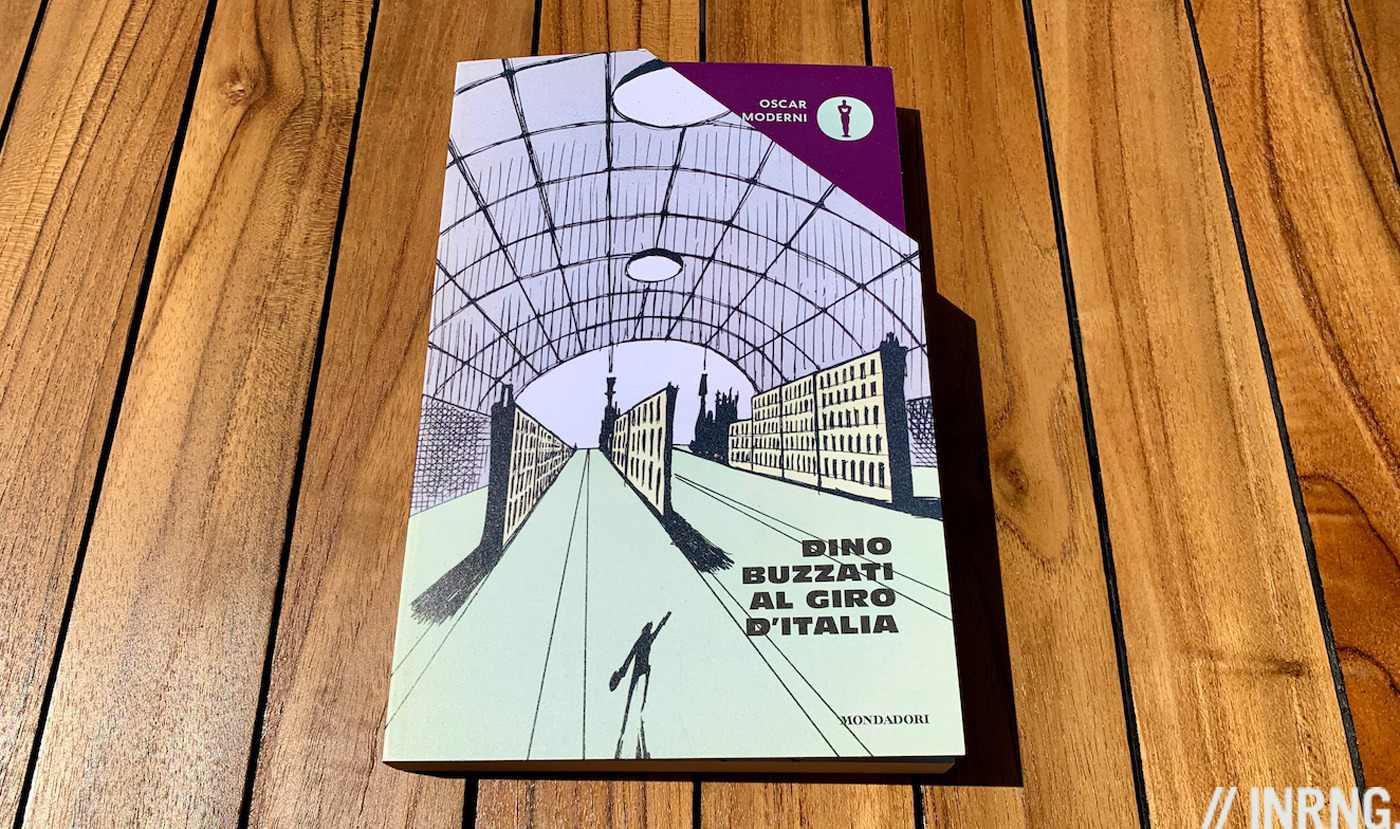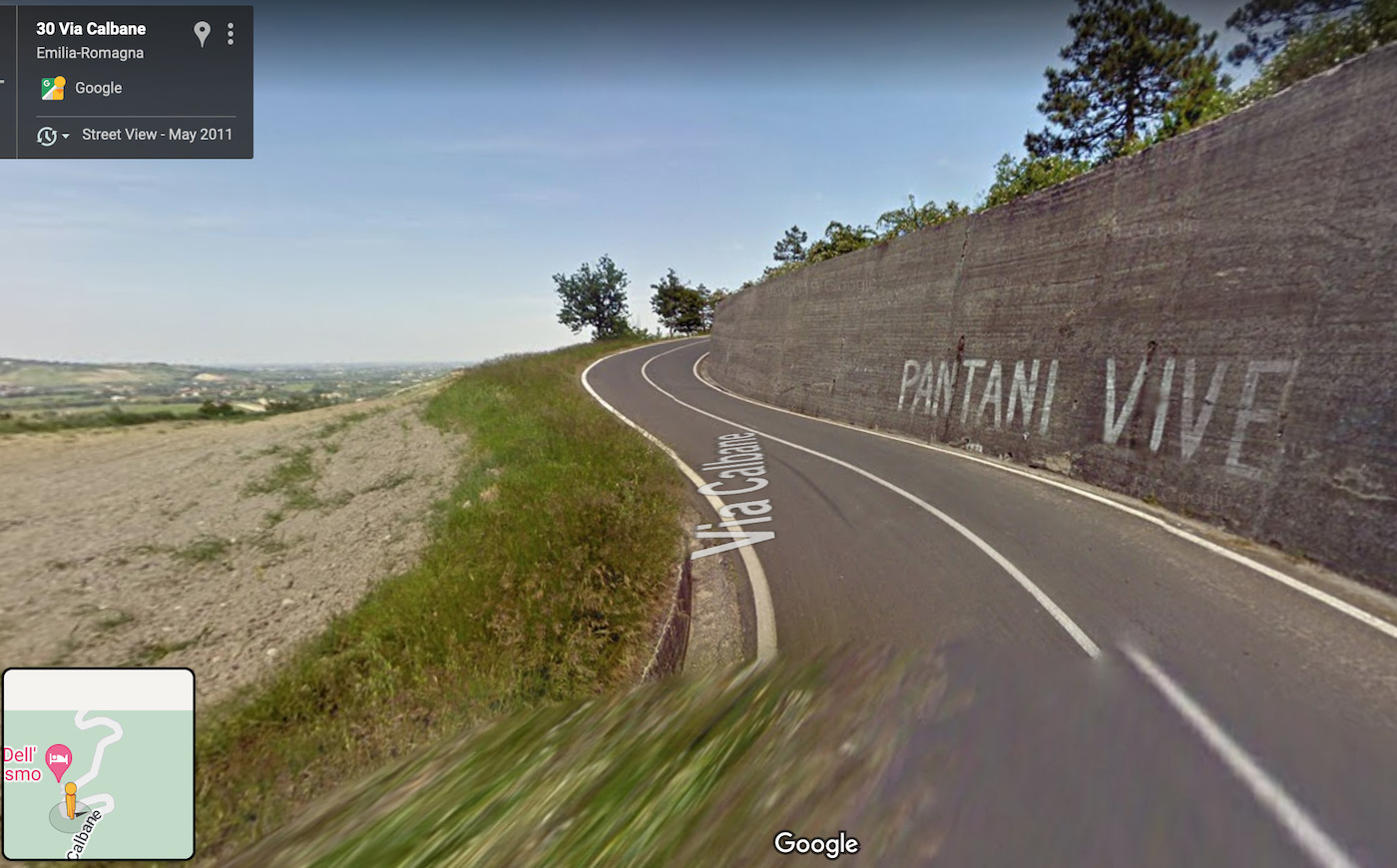With a rest-travel day in the Giro, why not pull out a book whether you’re travelling or looking for something to replace the TV coverage for a day? Dino Buzzati’s account of the 1949 Giro d’Italia stands the test of time. A writer dispatched as a special correspondent it is as much the story of Italy and its people as it is of the race where Fausto Coppi and Gino Bartali duel. Many of the Giro’s sights and sounds from 1949 often find a reflection or an echo today.
It’s been translated into English, Spanish, German and French so many readers can enjoy it.
Dino Buzzati is celebrated as a 20th century novelist for works such as Il deserto dei Tartari – the Tartar Steppe in English – he was also a journalist for the Corriere Della Sera, a newspaper. He’d been their war correspondent and was their special envoy sent to cover the 1949 Giro d’Italia alongside in-house sports reporter Ciro Verratti. “At the Giro d’Italia” is the collection of his columns from the race that year.
Buzzati is clear from the start that he’s never seen a bike race before and asks aloud what might become. With a colleague tasked with writing the race reports, he’s free to explore whatever catches his eye. Now a procedural account of the 1949 Giro race might still be interesting given this has become a mythical edition, but here Buzzati can touch on the racing but also describe his country, the people and much more. When Buzzati spots a smile on Bartali’s face it’s as telling as anything his legs could do. The results of each stage are published at the back of the book but it never feels important to read them.
Buzzati’s not the first writer sent to cover a bike race. Albert Londres was famous for it and playwright Antoine Blondin had a parallel career as a columnist for L’Equipe every July. There are touches of both as Buzzati is in awe of those who traverse Italy “by the force of the legs”, but there are many gentle observations à la Blondin. Being an outsider allows for simple observations that insiders overlook, being a writer allows him to craft these observations into playful prose. A time trial becomes “the only race where the last arrive first and the first arrive last” and there are paragraphs about Italy’s borders, patriotism, celebrity or what the race looks like when viewed from afar that are a delight to read. The column about Serse Coppi and who, and what, is a gentle tribute, as good as any of his observations about Gino Bartali and Fausto Coppi across the three weeks.
The more of the race Buzzati covers, the more he gets into the sport. At first he’s more interested in the crowds by the road, or the travel, a “pilgrimage from one trattoria to the next” . But he’s hooked by the racing eventually to the point that he writes about a fine day’s sport on Stage 10 while lamenting that all the so-called experts of the sport are more interested in the following day’s mountain stage in the Alps to Bolzano because of the Coppi-Bartali match rather than the action in front of them.
The Giro d’Italia has become a palimpsest where each edition writes a new story on top of all the past years, the 2022 edition can’t exist without all the precedent editions. To read about the 1949 edition during the 2022 race is to see the comparisons. So little has changed: a trip to Sicily, many of the same mountain passes, even the same stages with a Sanremo to Cuneo via the Colle di Nava in each edition. So much has changed: Buzzati notes the Giro’s visit through Cassino, scene of huge bombardments and a place where nobody was at the windows to wave the race past because “the windows were missing, even the walls were missing where the windows should have been”, although these scenes are happening a day’s drive way in Ukraine. It’s a reminder that Italy’s a relatively new country, especially in its undivided form today.
There’s nostalgia in the book for the old days of Girardengo, just as today’s Giro evokes Coppi and Bartali, and Marco Pantani. The race is faster than ever, we might lament how today’s cycling can have technical aspects worthy of motorsport at times, but Buzzati also witnesses a “galloping” and “electric” stage ridden at… 37km/h. The story of the race should always count more than the speed.
Buzzati finishes the book as one of the Girini, he’s someone who has done the Giro and become an insider. He seems convinced about the race as a symbol for Italy’s (re)construction. But Buzzati’s last column wonders if it will last:
“E il prossimo anno, sarà data di nuovo la partenza e l’anno dopo ancora, di primavera in primavera…Finchè (ma vivremo ancora noi?) le persone ragionevoli diranno che è assurdo continuare; a quei tempi le biciclette saranno diventate rare, ferravecchi quasi comici, usati da pochi nostalgici maniaci, e voci si leveranno dando la baia al Giro.”
Buzzati is asking how long the Giro will survive, suggesting one day bikes will become “almost comic lumps of junk used by a few nostalgic maniacs”. The bicycle has many great days ahead and everything suggests the Giro should do too. The editorial in La Gazzetta Dello Sport ahead of this year’s race wrote the Giro is “a mirror in which we have recognized ourselves for over a century”, seemingly reprising Buzzati.
The Verdict
Not quite the story of the 1949 Giro d’Italia but a collection of essays from the 1949 race and all the better for it. Buzzati is able to write as a special correspondent rather than being obliged to write up each stage and he can branch off to explore history, food or the people along the way, to read this is to soak up observations of early post-War Italy but also to enjoy a timeless account of the race. Ideally read it slowly, a day at a time because there’s no rush, don’t be hurried to the end of each stage’s account to find out who won each day. To understand the Giro better today it pays to read this account and students of Italian or Italophiles wanting a book about the Giro could enjoy this, it’s written for a wider public than the sports pages. Various translations and audiobook versions make it more accessible.
More book reviews at inrng.com/books



Italy had a strong tradition of writers who were sent to follow the Giro. Vasco Pratolini did before Buzzati, then a few years later I can also remember Anna Maria Ortese or Milena Milani. I think that the poet Alfonso Gatto even covered a Tour, besides the Giro. Screenwriter Cesare Zavattini who wrote so many Italian neorealism masterpieces also had an experience as a Giro journo.
Then you have the journalists who can sport a serious literary prose like Brera or Mura, but that’s a different story, of course.
By the way… surely I’ve named it here before, but Giovanni Testori’s “Il dio di Roserio” is one of the best literary fiction pieces ever dedicated to competitive cycling.
Anyway, as inrng excellent’s post already pointed out, the added value of this book is being available in several languages, which probably doesn’t apply to most of the above mentioned. Giovanni Testori’s work has been long studied internationally, thus there’s a good deal of research work on it in English, but I can’t say right now if his text as such was ever translated!
I’m not familiar with these works but from various sources that I have read, sport was an important mechanism by which to rehabilitate post-Fascist Italy to the outside world after WW2.
And also to help bring a somewhat divided nation together again; Italy had narrowly voted to become a republic in 1946. The north of the country had voted in majority for the Republic, the south to retain the monarchy.
(Interestingly the national football team kept the royal colours of the House of Savoy, the Azzurri).
I can see that events like the Giro could be used by writers and the media (and their owners of course) to foster a raised sense of awareness, pride and belonging in difficult times.
This looks like an excellent read.
“Il deserto dei Tartari” is among those classics you will have to read for school, one that is considered as part of the common culture in Italy, like Hamlet in Britain or The Grapes of Wrath in the US. And because of that, it can only be boring to read and study… Until you rediscover it as an adult and leaves a mark that never washes off, and you wonder what you were thinking about in middle school.
I didn’t know that Buzzati had written about the Giro d’Italia, but now that I do, I’ll definitely check it out. Many thanks for the review!
Somehow managed to avoid both in grade school.
That is unfortunately the fate of many a book worth reading for sheer pleasure and whatever it is that good literature gives us that we don’t learn when we read books for school.
I remember picking up books written by someone called Italo Calvino when I was 14 or 15 because the titles intrigued me and he has remained a favourite, go-to author ever since.
I was no longer at school when a translation of “Il deserto dei Tartari” was published. I can easily imagine that it can be explained and discussed to death 🙂 But since I didn’t have to write an essay or even do a multiple choice test I discovered a novel that I would include in any list of “Books in my life”.
PS At one point in my life I promised myself to learn Italian, but…well, I “listen quite fluently”.
Buzzati does remind me of Calvino, the prose is often refreshingly clear and simple, hopefully all the translations into other languages of both make them a good read.
Great review, thanks. The “race is not only the race” spirit lives on strongly in this site I think – and also the Cycling Podcast.
“La boutique del mistero” is another well known anthology of Buzzati
@gabriele Thanks for your recommendation, I will try to read Giovanni Testori’s “Il dio di Roserio”
This book is such a gem…
“It’s been translated into English, Spanish, German and French so many readers can enjoy it”.
Also in Dutch, although a quick search reveals it’s out of print – and a 2nd hand edition sells for nearly 30 euro which is rather pricey.